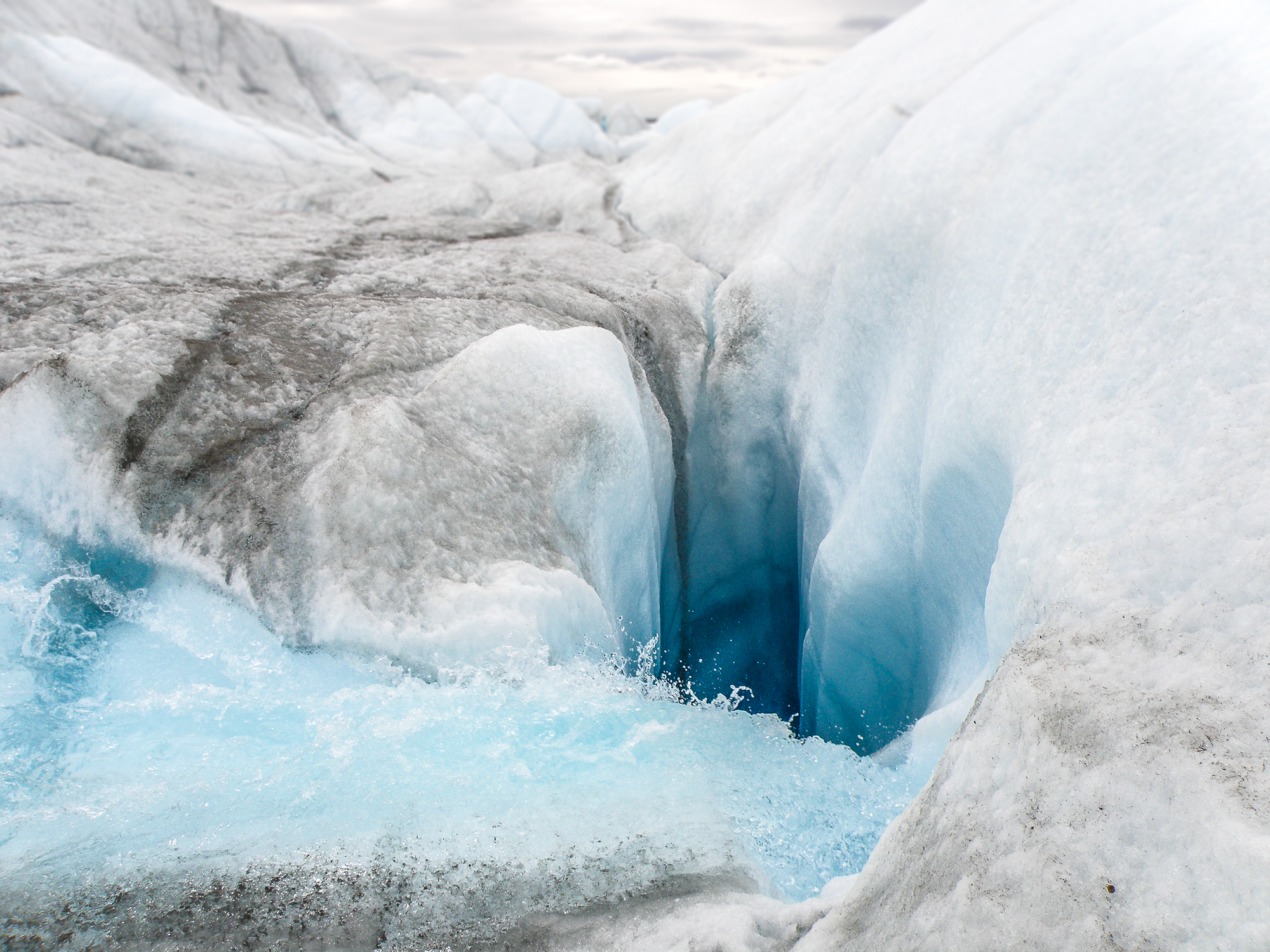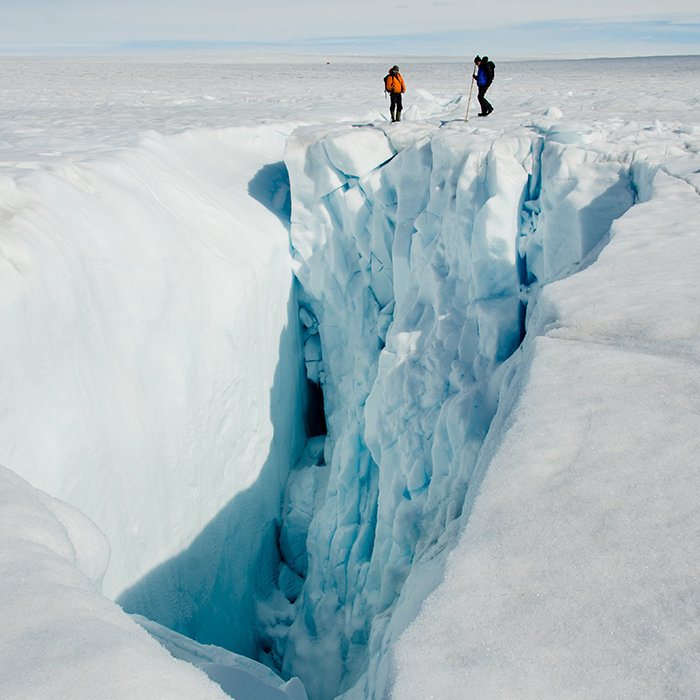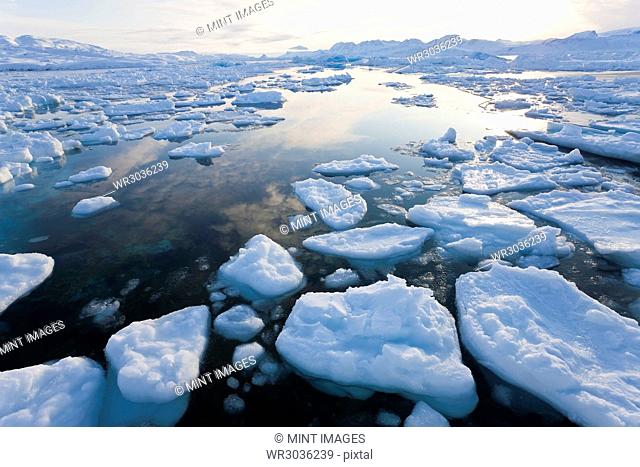The ice sheet is melting faster than in the last 350 years—and driving sea levels up around the world.
For a few days in July of 2012, it was so hot in the Arctic that nearly the entire surface of the Greenland ice sheet turned to slush.
It was so uncharacteristically warm that scientists, emerging from their tents high on the peak of the ice sheet, sank up to their knees in the suddenly soft snow. And then, that snow started melting.
Near the edge of the ice sheet, bright blue puddles collected on the flat white surface. Rivulets of melt trickled down, braiding into fat, gushing rivers. The meltwater punched through gullies and spilled down crevasses. One river near the edge of the ice sheet was so swollen that it swept away a bridge that had been there for decades. So much water spilled out of the guts of the ice sheet that year that global sea levels rose by over a millimeter.
The melting was alarming, like nothing scientists had seen before. But no one knew exactly how unusual the event was or how worried to be. But now, scientists have figured out that the hot 2012 summer capped off 20 years of unprecedented increases in meltwater runoff from Greenland. And even more concerning, they found, melting is speeding up even faster than air temperatures warm. So yes, they found, 2012 was a particularly bad year—but it was just a preview of what might come.
“The melting of the Greenland ice sheet is greater than at any point in the last three to four centuries, and probably much longer than that,” says Luke Trusel, a researcher at Rowan University in New Jersey and lead author of the new study, published today in Nature
And the effects of the melting aren’t just abstract: A complete melting of Greenland’s mile-thick ice sheets would dump seven meters (23 feet) of extra water into the world’s ocean. So what happens high in the poles matters to anyone who lives near a coast, eats food that comes through a coastal port, or makes a flight connection in an airport near the ocean, scientists warn.
Reading the ice like a book of the past
Scientists already knew that Greenland was melting fast; they could track its shrinking size from satellites. But the key satellite data only goes back until the early 1990s—so they couldn’t tell exactly how alarmed to be by the melting. Had this kind of jaw-dropping warming happened before? How unusual was it, compared to the time before human-caused climate change kicked into gear? No one knew.
They had to figure out a way to look back in time, so they went to the source: the ice sheet itself. They fanned across the ice surface and drilled a suite of ice cores that recorded signals of how much and how intensely the surface of the ice sheet had melted over the past few hundred years. They compared that with models, which let them calculate how much runoff would result from the kind of surface melting recorded in the ice cores.
And in both, they saw a clear signal. Melting and runoff started creeping upward just when the first stirrings of human-caused climate change hit the Arctic, in the mid-19th century. But the real drama unfolded in the past 20 years; suddenly, melt intensity shot up, up to nearly six-fold higher than it was before the Industrial Revolution.
“It’s really like turning on a switch,” says Beata Csatho, a glaciologist at the University at Buffalo.
And in both, they saw a clear signal. Melting and runoff started creeping upward just when the first stirrings of human-caused climate change hit the Arctic, in the mid-19th century. But the real drama unfolded in the past 20 years; suddenly, melt intensity shot up, up to nearly six-fold higher than it was before the Industrial Revolution.
“It’s really like turning on a switch,” says Beata Csatho, a glaciologist at the University at Buffalo.
The blob effect
It was also clear that melting was speeding up faster than the temperature rose. The warmer it got, the more sensitive the ice sheet was to that warming, primarily because melting at the surface changes its color.
“Think of a white fluffy snowflake,” explains Trusel. “As it melts, it’s going to become a blob.”
And blobs absorb more of the sun’s heat than fluffy, bright-white flakes. And the more heat they absorb, the blobbier they become, and the more they melt. “So even without any temperature change, once they get set in motion they just want to melt even more,” says Trusel.
That doesn’t bode well for the future, particularly because air temperatures in the Arctic are rising faster than anywhere else on the planet.
“What we're seeing right now is really unprecedented. These melt increases are driven by warming, which is caused by humans pumping greenhouse gases into the atmosphere,” says Ellyn Enderlin, a glacier scientist at the University of Maine. “The feedbacks the Earth has, the checks it has—they can't make up for that. The system can't adjust to the rate of change right now.”






No comments:
Post a Comment